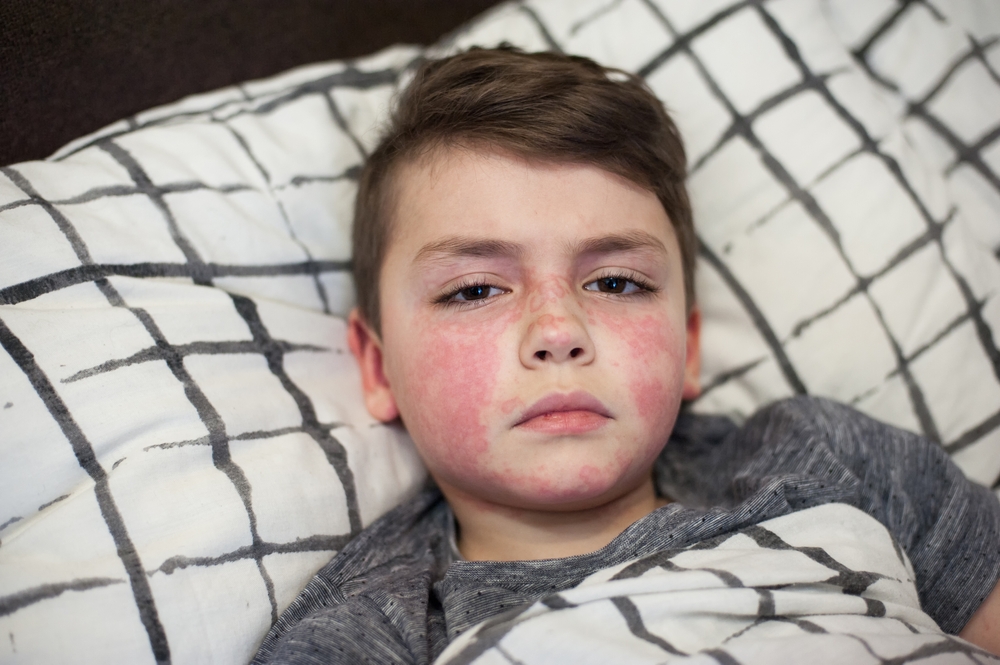
Information for Parents
Scarlet fever is due to a throat infection caused by a germ (bacterium) called Streptococcus pyogenes. It is sometimes called ‘Group A Strep’. It causes a rough-feeling red rash, sore throat, fever and sometimes other complications. It can occcur at any ages but is most common in children aged 2-8 years.
In scarlet fever, the streptococcus bacterium releases toxins that spread through the body. The toxins cause the rash and, if untreated, can cause problems in the kidneys and heart even years later.
What are the symptoms of scarlet fever?
Scarlet fever is a mild, self-limiting illness. Most children will recover fully within a week or so.
Scarlet fever starts with a sore throat, high temperature (fever), headache, fatigue, nausea and vomiting. Sometimes the tongue goes red, with tiny white spots. This makes it look like a strawberry. After this (12 to 48 hours) comes a red rash on the cheeks, chest and tummy. The rash feels slightly rough, like fine sandpaper. After a couple of days the tongue goes very red and a bit bigger than usual.
If symptoms are severe, seek medical advice immediately from your doctor. Antibiotics may be prescribed.
If not severe and left untreated, the rash and sore throat will fade over about a week, but the skin sometimes peels (like with sunburn).
Not all people with streptococcal infections develop the rash, as some people are not sensitive to the toxin. A mild form of scarlet fever may occur; this is often called Scarlatina.
What do I need to know?
The diagnosis can be made on the clinical picture. No tests are usually necessary. If there is any doubt, a doctor can take a throat swab to test for the germ (bacterium) that causes scarlet fever. The results will take a few days to come back, so if scarlet fever is suspected it’s usually best to start the antibiotics first.
There is a blood test which can detect the scarlet fever germ (the anti-streptolysin titre test, or ASO for short). But this is only positive after the infection so it will only tell you if your child had scarlet fever in the past.
The best treatment is antibiotics. Other supportive measures you can do at home are:
Treatment with antibiotics reduces the chance of complications. Complications now occur very rarely. However, if they do occur, they can be serious. This is why it’s important to take the full course of antibiotics.
Early complications occur within days. These complications are due to spread of the infection and include:
Later complications are rare. They happen weeks or months after the infection has gone. The body’s immune system, rather than the germ itself, cause the problem. These may include:
Scarlet fever is contagious. Coughing, sneezing and breathing out the germs (bacteria) can pass it on to others. Scarlet fever can even be passed on by sharing towels, clothes or bed linen with a person who has been infected.
It takes 2-4 days to develop symptoms after being infected. You should keep your child off school and away from others, for 24 hours after starting antibiotics.
When to be concerned
You should return to The Children’s Urgent Care Centre (0800-2000 Monday-Sunday) or Accident and Emergency (out of hours) if your child has any of the following symptoms:
Further Information
If you need any more information or advice between the hours of 0800-2000 Monday-Sunday please call The Children’s Urgent Care Centre on 02073906150.
Out of hours please contact NHS 111.
Call NHS 111 if you need medical help fast, but its not life threatening- for example, if you:
In case of emergency please call 999 or attend your local Children’s Emergency Department.
For more information on Scarlet Fever, please click HERE for information from the National Institute of Health and Care Excellence.